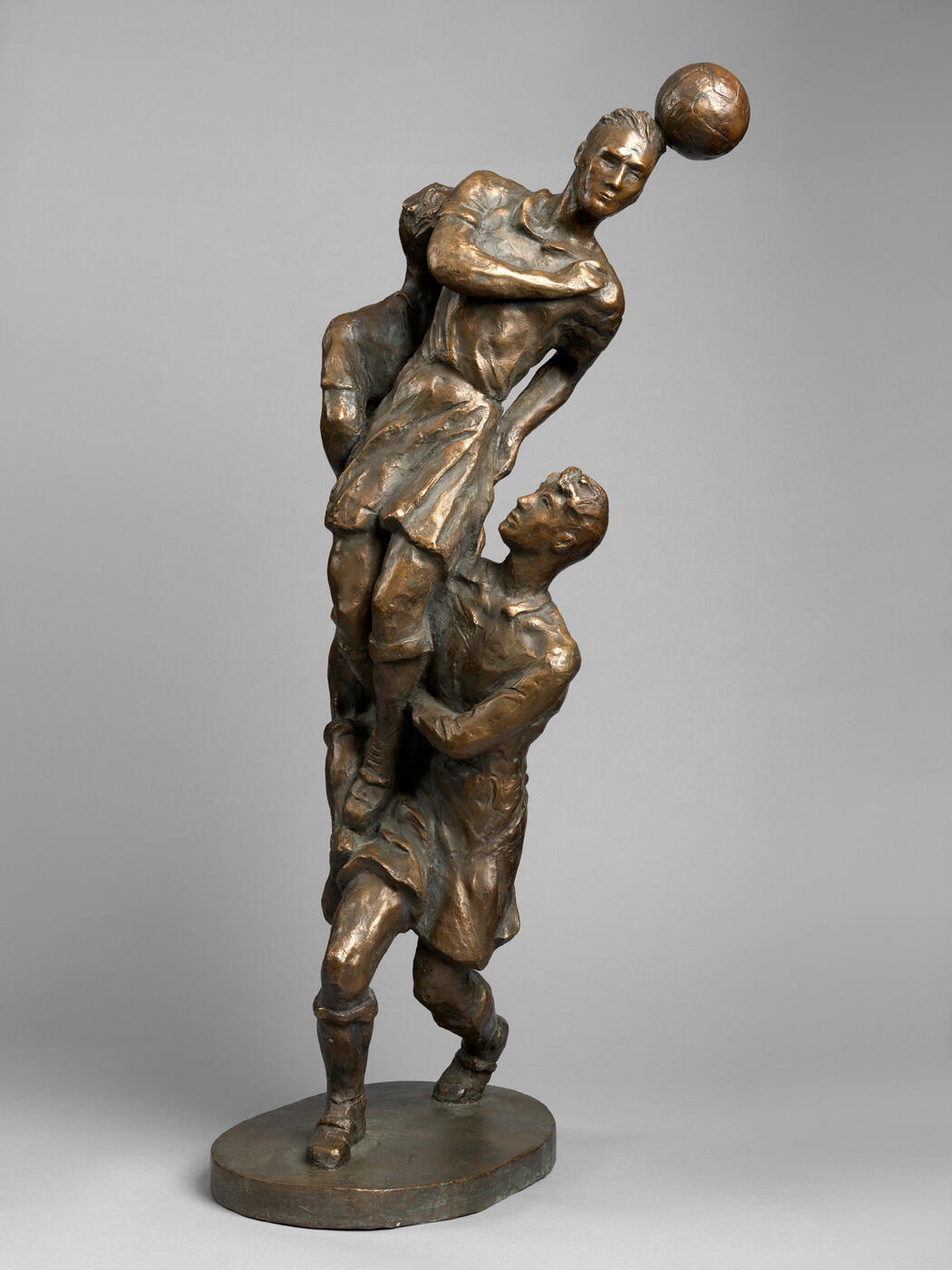30 November 2016 Russian Art Auctions
30 November 2016

* 18. DEINEKA, ALEKSANDR (1899-1969)
Football Players
Bronze, height 81 cm.
60,000–90,000 GBP
Provenance: Acquired by the present owner in Moscow in 1998.
Private collection, Switzerland.
Literature: Deineka. Monumentalnoe iskusstvo. Skulptura, Moscow, 2011, p. 331, No. 40/3, listed.
Related literature: For the initial composition in wood, see Alexandr Deineka. Zhivopis. Grafika. Skulptura, Moscow, The State Tretyakov Gallery, 2010, p. 13, pl. 3, illustrated, with incorrect listing; p. 185, illustrated; p. 198, No. 160, listed.
The sculptural group Football Players by Alexandr Deineka, offered here for auction, is the author’s bronze cast of his eponymous wooden sculpture. Deineka’s decision to produce this and two other known casts of the same sculpture is specifically connected with his artistic career in the late 1940s and 1950s.
As Deineka himself admitted, he first started dabbling in sculpture in the late 1930s, when he became interested in exploring three-dimensional space in art. However, most of his sculptures were executed after World War II, when he was head of the Sculpture Department at the Moscow Institute of Applied and Decorative Arts. He used the Institute’s facilities to work with materials (bronze, wood and ceramic) that he rarely used in his pre-war work; therefore it is reasonable to assume that the recasting of the original wooden sculpture Football Players (1950, The State Tretyakov Gallery) into bronze was part of this learning process. In any case, Football Players is a work that further develops Deineka’s artistic objectives, which he explored in his series of sculptural studies, namely the representation of movement and the compositional structure of two figure, table-top sculptures.
Deineka’s choice of subject is not accidental, and his sculptures always have connections with his work in other art forms. The artist had been preoccupied since the 1920s with the idea of creating expressive compositions that captured movement in sport, and as a keen sportsman himself, he used his art to forge an image of the new Soviet citizen: an athlete with a “spring” in his step. All of Deineka’s works dedicated to sport are filled with an enthusiasm bordering on passion, for example, the famous large-scale painting Goalkeeper (1934) or the sculpture Football Player (1948–1950).
The artist was also passionate about boxing, football and skiing, and it was not from mere civic duty that he showcased these sporting activities in his works. He admitted that his first experiments with the artistic rendering of movement were inspired by football: “The game of football is what spurred me to find my own artistic language” (A. Deineka, “Tvorcheskaya komandirovka”, 1935, quoted in V. Sysoev (ed.), Alexandr Deineka, Moscow, 1989, vol. 2, p. 12).
When preparing to paint a picture or create a sculpture glorifying the game of football, Deineka made numerous sketches and was convinced that the composition should not be just a simple snippet of a real-life match. He strove to imbue these works with a special expressivity that would transform immediate impressions into signs and symbols. The artist found this expressivity primarily when vigorous sporting movement – jumping and running – was viewed from certain angular perspectives, from above or below, and as such, was reminiscent of Alexandr Rodchenko’s photographs, so much in vogue at the time.
For his new Soviet hero, Deineka conceived an ideal of physical beauty quite different from that of classical art: a muscular, agile body, shaped by daily work and polished by sport, with short, strong legs, a svelte torso and a small head on broad shoulders. In this, his athletes of the late 1940s are no different from their pre-war predecessors. From 1948 and on into the 1950s, the artist created several sculptures and relief compositions on the subject of football. These are the reliefs on the grid, Football Players and Football Player, as well as several relief portraits of a football player’s head.
The sculpture presented here at auction further develops this series. The artist successfully addresses a difficult challenge, trying simultaneously to experiment with volume and composition. Deineka’s relaxed treatment of proportion and form highlight his familiarity with the uninhibited sculptural language of the leading European masters of the early 20th century. These features make Football Players one of Deineka’s best sculptural works, fully in keeping with the vitality of his sporting works of the 1930s.
In the years to follow, other artists’ versions of this and other famous compositions by Deineka – divers suspended over water, footballers depicted from a complex angle – would be transformed into a banal template for the decoration of Soviet social and recreational spaces. But that does not detract from the artistic merits and perfection of the original.
Notes on symbols:
* Indicates 5% Import Duty Charge applies.
Ω Indicates 20% Import Duty Charge applies.
§ Indicates Artist's Resale Right applies.
† Indicates Standard VAT scheme applies, and the rate of 20% VAT will be charged on both hammer price and premium.